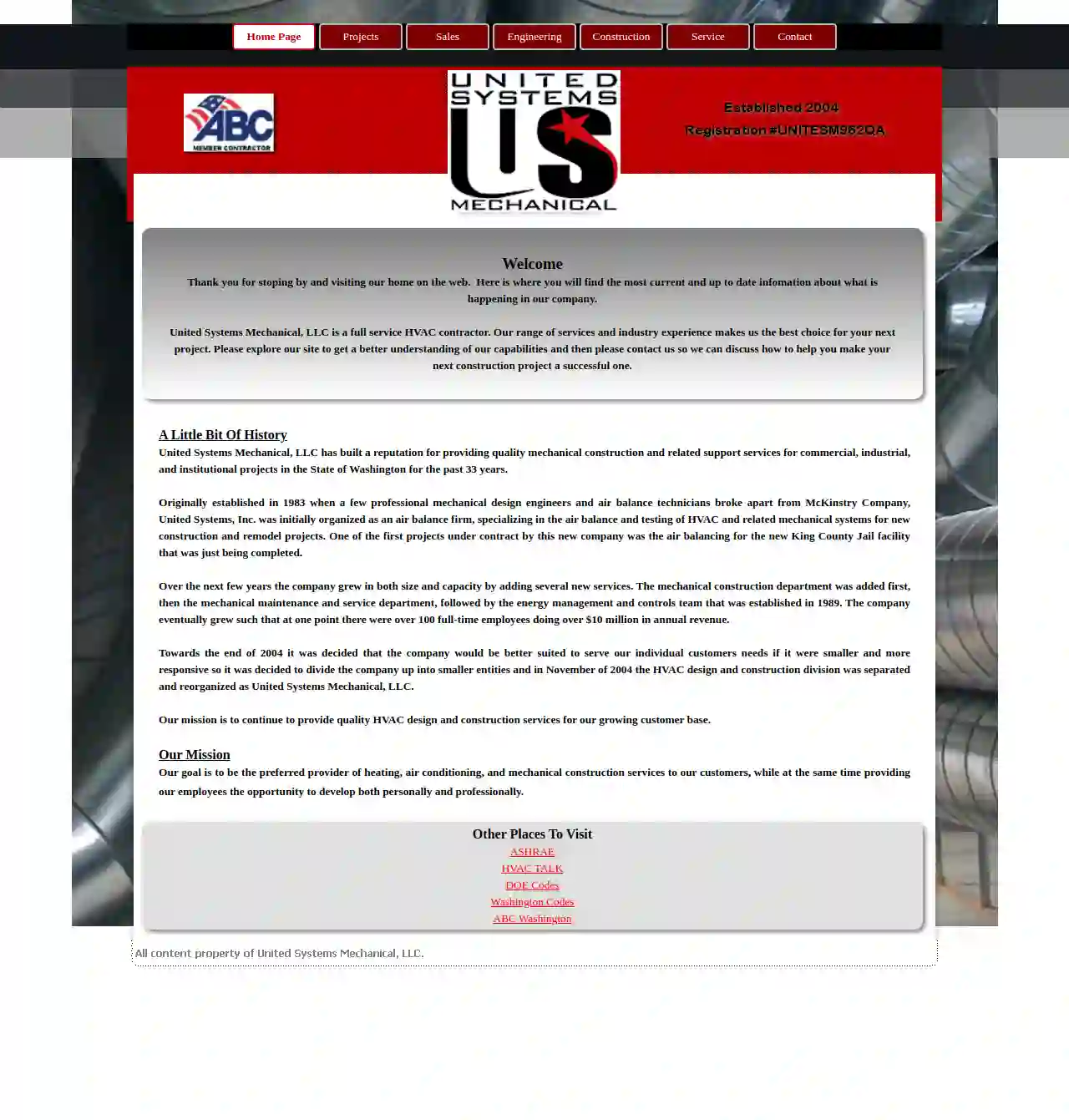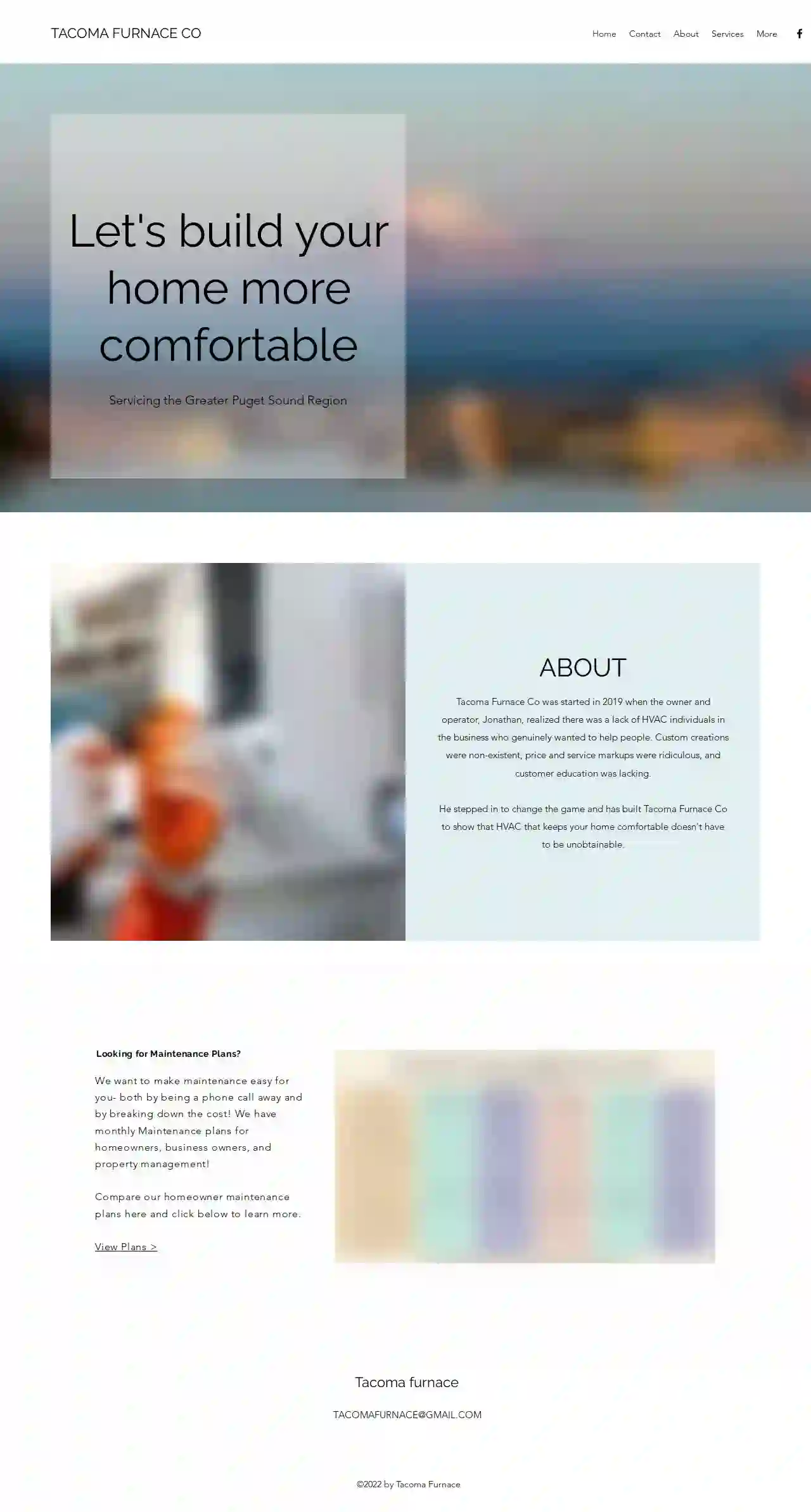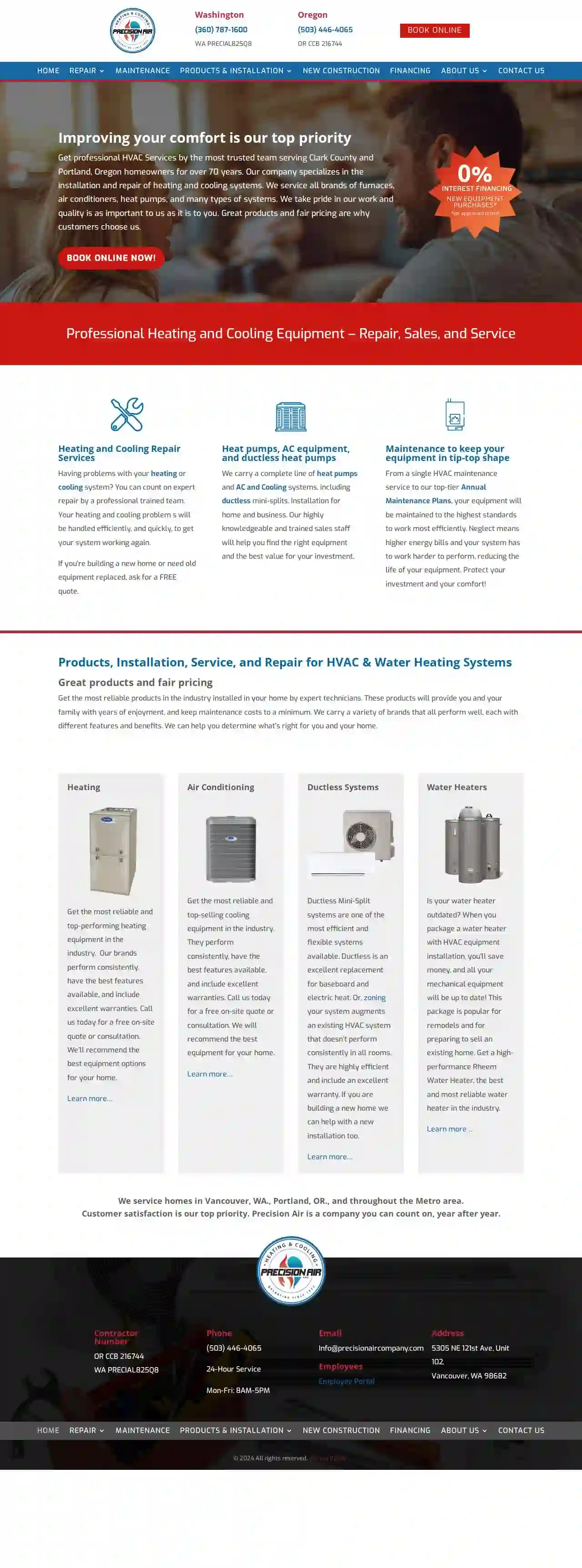Air Duct Cleaning Washougal
Top Duct Cleaning in Washougal
Get up to 3 Air Duct Cleaning quotes for your project today! Compare profiles, reviews, accreditations, portfolio, etc... and choose the best deal.

Capital Heating, Cooling, Plumbing & Electric
4.91218 Carpenter Road S.E., Lacey, 98503, USWith over 80 years of experience in heating and cooling, we know fixing or replacing a heating or cooling system is a big deal. We’re here to help.
- Services
- Why Us?
- Gallery
Get Quote
United Systems Mechanical
52 reviews1400 Airport Way South, #202, Seattle, 98134, USWelcome, thank you for visiting our website! Here you'll find the latest information about United Systems Mechanical, LLC. We're a full-service HVAC contractor with a wide range of services and industry experience, making us the ideal choice for your next project. Explore our site to learn more about our capabilities and then contact us to discuss how we can help make your construction project a success. A Little Bit of History United Systems Mechanical, LLC has built a reputation for providing quality mechanical construction and related support services for commercial, industrial, and institutional projects in Washington state for the past 33 years. Founded in 1983 by a group of experienced mechanical design engineers and air balance technicians who left McKinstry Company, United Systems, Inc. initially focused on air balancing and testing HVAC and related mechanical systems for new construction and remodel projects. One of their first projects was air balancing for the new King County Jail facility. Over the years, the company expanded its services, adding mechanical construction, maintenance and service, and an energy management and controls team established in 1989. At its peak, the company employed over 100 full-time staff and generated over $10 million in annual revenue. In late 2004, the company decided to become more customer-focused and responsive by dividing into smaller entities. The HVAC design and construction division was reorganized as United Systems Mechanical, LLC in November 2004. Our mission is to continue providing high-quality HVAC design and construction services to our growing customer base. Our Mission Our goal is to be the preferred provider of heating, air conditioning, and mechanical construction services to our customers while providing our employees with opportunities for personal and professional growth. Other Places To Visit ASHRAE, HVAC Talk, DOE Codes, Washington Codes, ABC Washington
- Services
- Why Us?
- Our Team
- Gallery
Get Quote
Tacoma Furnace Company
52 reviewsTacoma, USTacoma Furnace Co was started in 2019 when the owner and operator, Jonathan, realized there was a lack of HVAC individuals in the business who genuinely wanted to help people. Custom creations were non-existent, price and service markups were ridiculous, and customer education was lacking. He stepped in to change the game and has built Tacoma Furnace Co to show that HVAC that keeps your home comfortable doesn't have to be unobtainable. We want to make maintenance easy for you- both by being a phone call away and by breaking down the cost! We have monthly Maintenance plans for homeowners, business owners, and property management! Compare our homeowner maintenance plans here and click below to learn more. View Plans >
- Services
- Why Us?
- Gallery
Get Quote
Precision Air
4.9161 reviews5305 NE 121st Ave, Unit 102, Vancouver, 98682, USImproving your comfort is our top priority. Get professional HVAC Services by the most trusted team serving Clark County, WA and Portland, Oregon homeowners for over 70 years. Our company specializes in the installation and repair of heating and cooling systems. We service all brands of furnaces, air conditioners, heat pumps, and many types of systems. We take pride in our work and quality is as important to us as it is to you. Great products and fair pricing are why customers choose us. Book online now! We Service All Types And Brands Of Heating And Air Conditioning Systems. Heating and Cooling Repair Services. Having problems with your heating or cooling system? You can count on expert repair by a professional trained team. Your heating and cooling problem s will be handled efficiently, and quickly, to get your system working again. If you’re building a new home or need old equipment replaced, ask for a FREE quote. Heat pumps, AC equipment, and ductless heat pumps. We carry a complete line of heat pumps and AC and Cooling systems, including ductless mini-splits. Installation for home and business. Our highly knowledgeable and trained sales staff will help you find the right equipment and the best value for your investment. Maintenance to keep your equipment in tip-top shape. From a single HVAC maintenance service to our top-tier Annual Maintenance Plans, your equipment will be maintained to the highest standards to work most efficiently. Neglect means higher energy bills and your system has to work harder to perform, reducing the life of your equipment. Protect your investment and your comfort! Products, Installation, Service, and Repair for HVAC & Water Heating Systems. Great products and fair pricing. Get the most reliable products in the industry installed in your home by expert technicians. These products will provide you and your family with years of enjoyment, and keep maintenance costs to a minimum. We carry a variety of brands that all perform well, each with different features and benefits. We can help you determine what’s right for you and your home. Heating. Get the most reliable and top-performing heating equipment in the industry. Our brands perform consistently, have the best features available, and include excellent warranties. Call us today for a free on-site quote or consultation. We’ll recommend the best equipment options for your home. Learn more… Air Conditioning. Get the most reliable and top-selling cooling equipment in the industry. They perform consistently, have the best features available, and include excellent warranties. Call us today for a free on-site quote or consultation. We will recommend the best equipment for your home. Learn more… Ductless Systems. Ductless Mini-Split systems are one of the most efficient and flexible systems available. Ductless is an excellent replacement for baseboard and electric heat. Or, zoning your system augments an existing HVAC system that doesn’t perform consistently in all rooms. They are highly efficient and include an excellent warranty. If you are building a new home we can help with a new installation too. Learn more… Water Heaters. Is your water heater outdated? When you package a water heater with HVAC equipment installation, you’ll save money, and all your mechanical equipment will be up to date! This package is popular for remodels and for preparing to sell an existing home. Get a high-performance Rheem Water Heater, the best and most reliable water heater in the industry. Learn more… We service homes in Vancouver, WA., Portland, OR., and throughout the Metro area. Customer satisfaction is our top priority. Precision Air is a company you can count on, year after year.
- Services
- Why Us?
- Accreditations
- Gallery
Get Quote
Comfort Air, Inc.
4.9512 reviews12800 NE 95th Street, Vancouver, 98682, USAs a property owner, your indoor comfort and safety are top priorities. That’s why our licensed technicians are committed to providing high-quality heating, cooling, plumbing, and electrical services in Vancouver. From new installations to preventive maintenance, Comfort 360 is here to protect your hard-earned investment with reliable, cost-effective solutions designed to last. Whether you’re frustrated with an unreliable water heater or need fast AC repair for your home or business, our certified experts have over 40 years of experience to diagnose and resolve your problem safely and effectively. Reach out to our fully insured and licensed team today to learn more about our special discounts, best-in-class products, and exceptional service! Comfort 360 is dedicated to restoring your indoor comfort with prompt, professional service throughout Vancouver.
- Services
- Why Us?
- Gallery
Get Quote
ACES Heating & Cooling LLC
5157 reviewsKennewick, US- Services
- Why Us?
- Gallery
Get Quote
PSR Mechanical
4.615 reviews3132 NE 133rd Street, Seattle, 98125, USPSR Mechanical is a privately held commercial HVAC services company serving building owners and operators throughout Puget Sound. Established in 1945, we have partnered with clients to deliver reliable mechanical services and improve efficiencies for over 70 years. Every aspect of our industrial HVAC solutions are tied to the core goal of helping clients control the costs of owning and operating their facilities. PSR Mechanical delivers value beyond a service agreement. We help clients throughout Puget Sound control the cost and worry of owning and operating their facilities. Our skilled technicians ensure mechanical systems are efficient, reliable and effective - all day, everyday.
- Services
- Why Us?
- Gallery
Get Quote
Pro Duct
214 Albany Ave Suite C, Kennewick, USPro-Duct Inc. is a family owned and operated sheet metal fabrication company. Proudly serving the Tri-Cities, Washington area, Pro-Duct has become one of the largest sheet metal fabricators in Washington State. Our company’s success follows our commitment to quality, timeliness, and customer service. Pro-Duct has proudly fabricated sheet metal since 1992. Pro-Duct is a family owned and operated business located at Kennewick, Washington; we provide HVAC sheet metal, HVAC ducting pipe, and metal fabrication to industrial, commercial and residential customers. Pro-Duct is a full service sheet metal fabrication company. We have the experience and the knowledge to deliver the best products and services in the HVAC sheet metal industry. From a single home to large retail centers and high-rise complexes, we do it all. During the last fifteen years Pro-Duct has earned the business management recognition from both residential and commercial customers. Our team provides extensive experience to every project. All of our sheet metal fabrication services are in-house to ensure the best quality possible.
- Services
- Why Us?
- Accreditations
- Gallery
Get Quote
Air Design Heating & Air Conditioning
452 reviews1807 E Francis Ave, Spokane, 99208, USAir Design Heating and Air Conditioning is your Spokane Indoor Comfort Specialists since 1979. Need A Repair? Furnace and air conditioner repairs? Help is just a quick phone call away. Let us make it easy. (509) 487-4328 Schedule A Repair AC / Furnace Tune-UpServicing HVAC equipment and full scale heating and cooling repairs... Or just a filter change. We do it all! Get A Tune-Up Free EstimatesLooking to install a new air conditioner, furnace, or comfortable fire pit? Get in touch! We'll be right there. Get A Free Estimate Why Choose Air DesignHeating, Air Conditioning and Barton's Fireplace Shoppe Whether you are looking for quality installation, service or repair, better indoor air quality, or just a filter change, Air Design Heating & Air Conditioning is your best choice of Spokane heating contractors and cooling specialists. Air Design has been in business since 1979 and has a reputation for providing quality products and services.Spokane's Premier Heating and Cooling Company Owned by Spokane residents, we are committed to complete customer satisfaction and want to be the "Premier Heating and Air Conditioning Company” in the Spokane area. To become the best heating company in Spokane, we know we must be able to provide the highest quality and most energy efficient air conditioning and heating products on the market. But there is so much more to being the best. Air Design is also your Indoor Air Quality experts with a full product line of air cleaning products, as well as, your destination for fire pits - Come visit our showroom (North Spokane)!Come Visit Our Showroom 1807 E Francis Ave, Spokane, WA 99208 Air Conditioning Service in Spokane, WA When an air conditioning unit fails, it is usually during the hottest part of the season. Don’t get hot under the collar if this happens to you. Air Design is on call to help get you cooled down fast and affordably. Our air conditioning service in Spokane, WA will get your AC unit up and running again fast and affordably. We only use high quality parts and components to repair your Spokane air conditioner which carry industry standard warranties. You can rest assured that we will get the job done right the first time. Our air conditioning service technicians are licensed and certified to repair or replace all modern and common air conditioners in Spokane, WA. From simple filter changes to complex AC system replacement, our technicians have the skills, experience, and equipment necessary to get cool air flowing again. For more information about our air conditioning service in Spokane, WA, don’t hesitate to contact Air Design anytime. Heater and Furnace Service in Spokane, WA When the temperature begins to drop, don’t get left out in the cold if your heater or furnace quits working. No matter how you heat your home or business, Air Design in Spokane, WA can help you get warm and stay warm. Our highly experienced heater technicians can diagnose, service, repair, or replace faulty or worn out heater and furnace parts and systems fast and reliably. And they can work on just about any heater or furnace you own using factory authorized parts. In addition to our heater and furnace repair services in Spokane, WA, Air Design can even convert your old oil furnace to electric or gas! We also offer pre and post installation inspections to be absolutely sure of what you need to get the heat flowing again. Many of our heaters and furnaces are Energy Star® rated which can help you save up to 30% on your heating costs. We also service heat pumps and honor all manufacturer warranties so you can (warmly) rest assured that your heater or furnace will continue to provide consistent and efficient heat all winter long for years to come. Call Air Design at (509) 487-4328 today to schedule a free consultation.OUR SERVICESHeating ServicesWhen your furnace goes out – you want someone who will show up on time, be professional, resp
- Services
- Why Us?
- Accreditations
- Gallery
Get Quote
Northwest Ductless Heating & Cooling
58 reviewsSpokane, USNorthwest Ductless specializes in residential and light commercial installation of ductless heat pumps. We also service ductless heat pumps to ensure that they are heating and cooling properly and efficiently. We are locally owned and operated, serving North Idaho and the greater Spokane area. Installations are typically done in one day without the high stress of invasive construction. Ductless heat pumps are the perfect solution for heating and cooling entire homes as well as individual spaces. With a ductless heat pump, you can drastically lower your energy bills quietly and comfortably. The temperature demands that the northwest requires is easily met with a ductless heat pump. Today’s technology allows 100% heating capacity at -5°F and 70% to 81% heating capacity at -13°F. Northwest summers will feel cool and comfortable, being tailored to each person's desired temperature. Northwest Ductless specializes in ductless heating and cooling, USE THE SPECIALIST! We install America's number one selling and top-rated brand, Mitsubishi Ductless. We are Mitsubishi Diamond Contractors, customers get 12 Year Warranties!!! Built up dust or organic growth can cause any mini-split to underperform. We use specialized tools and methods to clean coils and blower wheels.
- Services
- Why Us?
- Gallery
Get Quote
Over 15,611+ HVAC Businesses onboarded
Our HVAC experts operate in Washougal & surroundings!
HVACCompaniesHub has curated and vetted Top HVAC Businesses arround Washougal. Find the most reliable contractor today.
Frequently Asked Questions about Air Duct Cleaning
Does air duct cleaning prevent mold?
How long does air duct cleaning take?
How do I deodorize my air ducts?
What is the NADCA standard for air duct cleaning?
Does air duct cleaning prevent mold?
How long does air duct cleaning take?
How do I deodorize my air ducts?
What is the NADCA standard for air duct cleaning?
This website uses cookies for personalization and marketing purposes. To learn more please check our Privacy Policy & Cookies Policy.